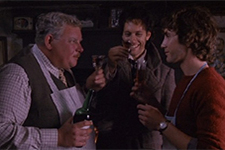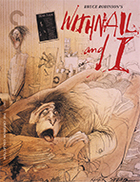Withnail & I (4K UHD)
|  Bruce Robinson’s Withnail and I is a dark black comedy spun from semi-autobiographical threads about two unemployed actors trying to make the best of times in the worst of times in London in late 1969. It features a bizarre cast of characters, has no real plot, and is shot in the rather dull, straightforward style of a first-time director trying to find his feet. Yet, it is a wonderfully written trip, more literary than cinematic, and the movie chugs forward on the inherent strength of its dialogue and performers. For this reason, it has garnered something of a cult following, especially in England, since its theatrical release nearly 40 years ago. Robinson had already had a semi-successful career as an actor in the late 1960s and throughout the ’70s, scoring minor roles in Franco Zefferelli’s Romeo and Juliet (1968) and Ken Russell’s The Music Lovers (1971), as well as the male lead opposite Isabelle Adjani in François Truffaut’s The Story of Adèle H. (1975). In the 1980s he turned to screenwriting, and his first script, for Roland Joffé’s The Killing Fields (1984), scored him an Oscar nomination. The script for Withnail & I actually began as an unpublished novel that Robinson wrote in 1969 that he then adapted into a screenplay and directed himself. The film was not particularly successful during its initial run, but it gained cult status on home video. Like The Rocky Horror Picture Show (1975), This Is Spinal Tap (1984), and other movies with cult followings, Withnail and I is endlessly quotable, offering line after line of dialogue whose most important characteristic is that they get funnier each time you hear them. On first viewing, Withnail and I is a shaggy, sometime ponderous movie about two very dislikable characters. But, each subsequent viewing unveils something you missed the first time around, usually in the dialogue—a throwaway line here, a pitch in the voice there, a reply that didn’t quite make sense the first time around. This, I think, is why so many people watch it over and over and over again: It keeps getting better. The two main characters are Withnail (Richard E. Grant) and Peter Marwood (Paul McGann), the “I” of the title (his name is never actually stated in the film). When the story opens, Withnail and Marwood are living in the filthy squalor of their flat in London, unemployed (probably, at least in Withnail’s case, unemployable), drowning themselves in booze and drugs and self-pity. These early scenes establish the two characters, portraying Marwood as a somewhat quiet and introspective young man who has, nonetheless, been drawn into Withnail’s orbit. Withnail, who was based on a friend of Robinson’s named Vivian MacKerrell who he met in drama school in the mid-1960s, is an utterly self-absorbed cad whose inflated view of himself radiates outward and tends to make him seem grander than he actually is. Withnail is a poser, full of hot air, lies, and complaints, yet there is something intensely attractive about him; his moaning has a kind of poetry to it. As Robinson wrote in the introduction to the film’s screenplay, “What Vivian was brilliant at was being Vivian,” which is equally true of Withnail. Desperate to escape the tedium of their sad lives in London, Withnail and Marwood decide to go to the country on holiday, using a cottage owned by Withnail’s wealthy and lecherous Uncle Monty (Richard Griffiths). We are introduced to Monty in a positively hilarious scene in which Withnail and Marwood attempt to pass themselves off as successful actors in Monty’s lavish drawing room while Monty, absurdly overweight and pompous, rambles on and on about the difference between carrots and flowers, which we eventually realize are bizarre metaphors for his barely suppressed homosexuality and lust for Marwood (Robinson based the character on Franco Zefferelli, who he claims sexually harassed him during the filming of Romeo and Juliet). About geraniums, he says, “Flowers are essentially tarts, prostitutes for the bees,” and then goes on about how there is “something very special about a firm, young carrot.” Yes—very special, indeed. Withnail and Marwood eventually make it out to Monty’s summer cottage, which they find a little more rustic than they had expected (“It’s like Greenland in here,” Withnail protests). With virtually no money between them, they are strapped to find firewood and food. They are also forced to deal, at various points, with inclement weather, a horny bull, and locals who don’t take kindly to pretentious urban types on holiday. Nothing, though, prepares them for the unexpected arrival of Monty, who decides to surprise them by spending the weekend at the cottage. Withnail is happy because Monty brings plenty of food and fine wine to keep him well-fed and inebriated. Marwood is not so pleased because it comes at his expense, as it becomes patently clear that Monty has set his sights on him and proceeds to pursue him in an increasingly aggressive fashion. Monty’s pompous stories and musings become more and more explicit in their sexual orientation, which makes Marwood more and more nervous. Withnail, self-absorbed as always, couldn’t care less as long he is full and drunk. And that is about all the film offers plot-wise, but that is not Robinson’s point. Rather, he is trying to evoke a feeling based on his own memories of being an aimless young man in the late 1960s with grand dreams and seemingly no place to go. What little plot exists is merely there to act as a framework on which he can evoke the grim, but comic dead-ended-ness of Withnail and Marwood’s lives. The movie is essentially a character study, and the end makes clear that it is Marwood who will move on in life, while Withnail will be forever trapped in his own cocoon of misplaced self-importance. Withnail and I is frequently hilarious in the way that real life is hilarious—in stops and starts. Some of the funniest lines come from a nonsensical, long-haired drug dealer named Danny (Ralph Brown), who exists for no other reason than to show that there are people like Danny in the world, the kind of people who talk a lot, but never really say anything. But, that is the kind of movie this is, interested less in the mechanics of narrative and more in the idiosyncrasies of that thing we call life. Shot on a low budget with a cast of then mostly unknown actors, Withnail and I is a triumph of personal vision, a movie that was conceived and executed in a very particular way without any compromise. I suspect that those who do not appreciate it, especially after several viewings, will simply never get it.
Copyright © 2025 James Kendrick Thoughts? E-mail James Kendrick All images copyright © The Criterion Collection | |||||||||||||||||||||||||||||
Overall Rating: 


 (3.5)
(3.5)


